Business Statistics and Data Analysis Assignment - University
VerifiedAdded on 2022/09/07
|7
|900
|21
Homework Assignment
AI Summary
This assignment solution covers key concepts in business statistics, focusing on sampling and distribution. It addresses the use of the finite population correction factor, range of sampling errors, and the variability of sampling distributions. The solution also differentiates between standard deviation and standard error, providing formulas and examples. Furthermore, it includes calculations for population means and standard deviations, along with discussion on sample size requirements for normal distributions. The assignment also incorporates case studies involving the analysis of survey data to develop subscriber profiles for a magazine, including questions on demographics and financial investments. Excel solutions are included for various questions and case problems.
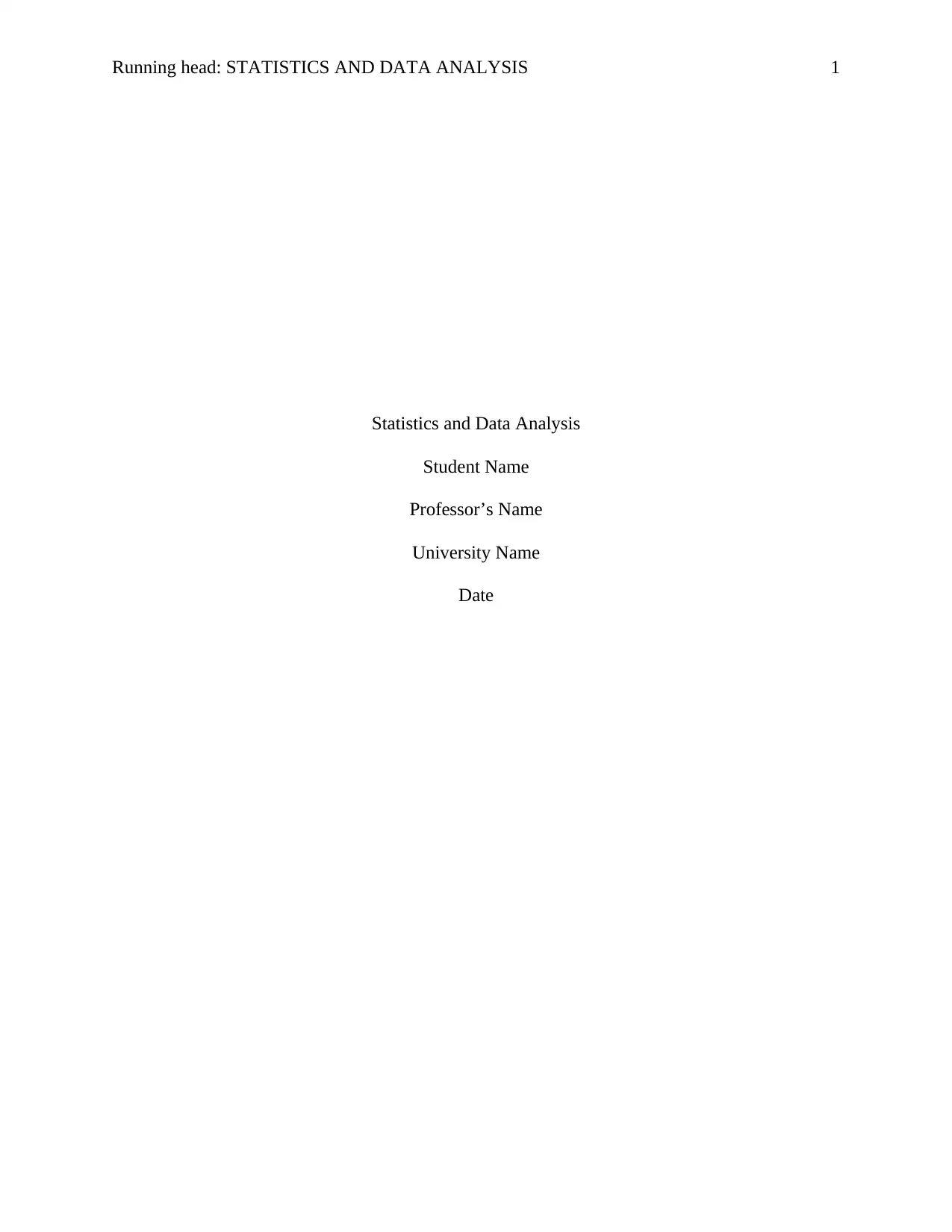
Running head: STATISTICS AND DATA ANALYSIS 1
Statistics and Data Analysis
Student Name
Professor’s Name
University Name
Date
Statistics and Data Analysis
Student Name
Professor’s Name
University Name
Date
Paraphrase This Document
Need a fresh take? Get an instant paraphrase of this document with our AI Paraphraser
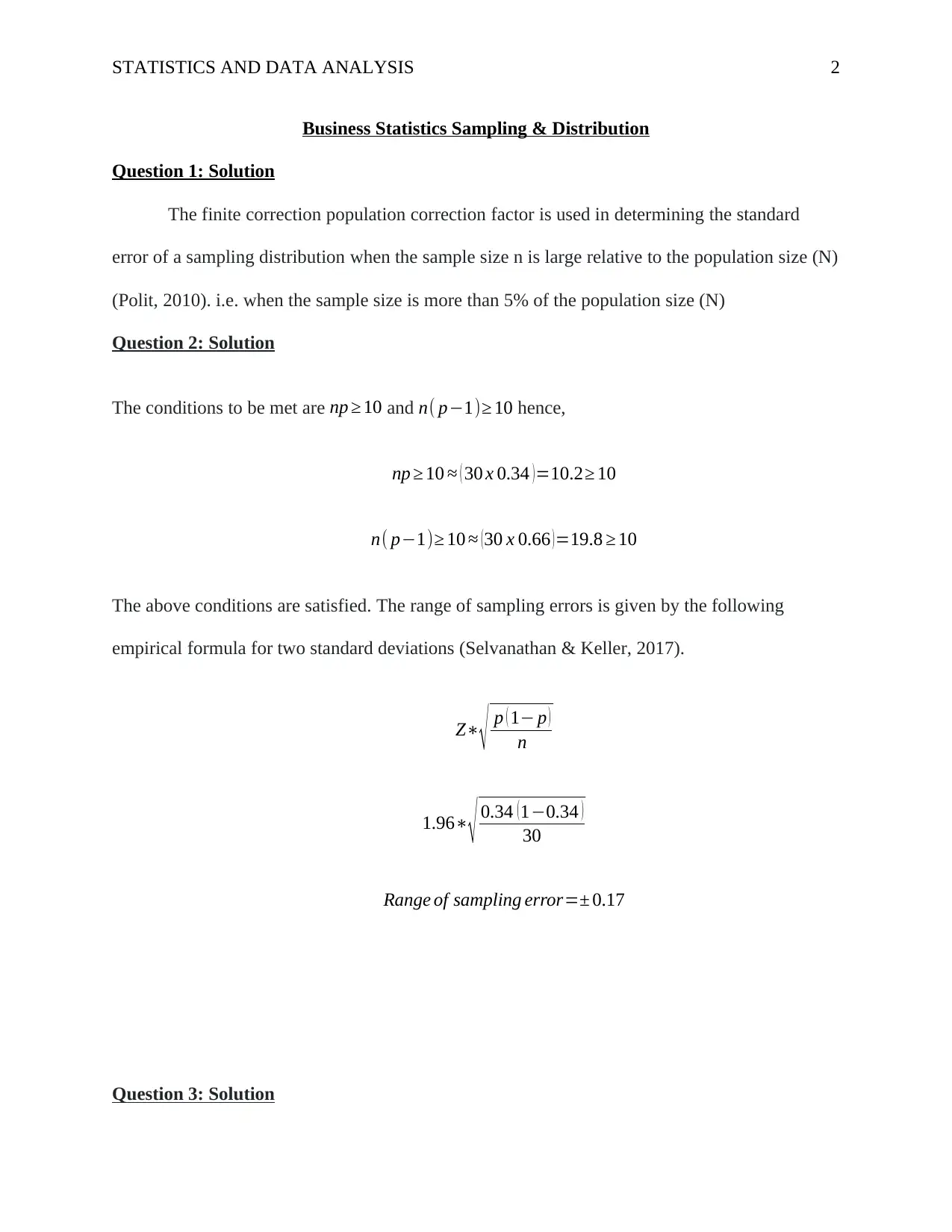
STATISTICS AND DATA ANALYSIS 2
Business Statistics Sampling & Distribution
Question 1: Solution
The finite correction population correction factor is used in determining the standard
error of a sampling distribution when the sample size n is large relative to the population size (N)
(Polit, 2010). i.e. when the sample size is more than 5% of the population size (N)
Question 2: Solution
The conditions to be met are np ≥ 10 and n( p−1)≥ 10 hence,
np ≥ 10 ≈ ( 30 x 0.34 )=10.2≥ 10
n( p−1)≥ 10 ≈ (30 x 0.66 )=19.8 ≥ 10
The above conditions are satisfied. The range of sampling errors is given by the following
empirical formula for two standard deviations (Selvanathan & Keller, 2017).
Z∗
√ p ( 1− p )
n
1.96∗
√ 0.34 (1−0.34 )
30
Range of sampling error=± 0.17
Question 3: Solution
Business Statistics Sampling & Distribution
Question 1: Solution
The finite correction population correction factor is used in determining the standard
error of a sampling distribution when the sample size n is large relative to the population size (N)
(Polit, 2010). i.e. when the sample size is more than 5% of the population size (N)
Question 2: Solution
The conditions to be met are np ≥ 10 and n( p−1)≥ 10 hence,
np ≥ 10 ≈ ( 30 x 0.34 )=10.2≥ 10
n( p−1)≥ 10 ≈ (30 x 0.66 )=19.8 ≥ 10
The above conditions are satisfied. The range of sampling errors is given by the following
empirical formula for two standard deviations (Selvanathan & Keller, 2017).
Z∗
√ p ( 1− p )
n
1.96∗
√ 0.34 (1−0.34 )
30
Range of sampling error=± 0.17
Question 3: Solution

STATISTICS AND DATA ANALYSIS 3
The sampling distribution is less variable than the population distribution because the sample
means do not vary as much as the individual values in the population (Freund, 2014). For
example, we needed to determine a statistical parameter for the population we would have to use
individual outcomes which can take a wide range of values that could either be very extreme or
less extreme. On the other hand, if we needed to determine the same parameter using the sample,
we would use the values in the sample and even though the extreme value in the sample would
have an effect would be reduced by the other values in the sample. With an increase in sample
size the effect of a single extreme value would be made smaller due to the averaging with more
values (Fowler, 2009).
Question 4: Solution
Similarity
The only similarity between standard deviation and standard error is that they are used in
experimental studies to present the characteristics of sample data to give a description of
statistical analysis results (Hinton, 2014).
Differences
Standard deviation is the measure of dispersion or spread of a set of values from
the mean while standard error is the measure of statistical exactness of an
estimate.
Standard deviation is descriptive while standard error is inferential.
Standard deviation is the square root of variance while standard error is the
standard deviation divided by the square root of the sample size.
The sampling distribution is less variable than the population distribution because the sample
means do not vary as much as the individual values in the population (Freund, 2014). For
example, we needed to determine a statistical parameter for the population we would have to use
individual outcomes which can take a wide range of values that could either be very extreme or
less extreme. On the other hand, if we needed to determine the same parameter using the sample,
we would use the values in the sample and even though the extreme value in the sample would
have an effect would be reduced by the other values in the sample. With an increase in sample
size the effect of a single extreme value would be made smaller due to the averaging with more
values (Fowler, 2009).
Question 4: Solution
Similarity
The only similarity between standard deviation and standard error is that they are used in
experimental studies to present the characteristics of sample data to give a description of
statistical analysis results (Hinton, 2014).
Differences
Standard deviation is the measure of dispersion or spread of a set of values from
the mean while standard error is the measure of statistical exactness of an
estimate.
Standard deviation is descriptive while standard error is inferential.
Standard deviation is the square root of variance while standard error is the
standard deviation divided by the square root of the sample size.
⊘ This is a preview!⊘
Do you want full access?
Subscribe today to unlock all pages.

Trusted by 1+ million students worldwide
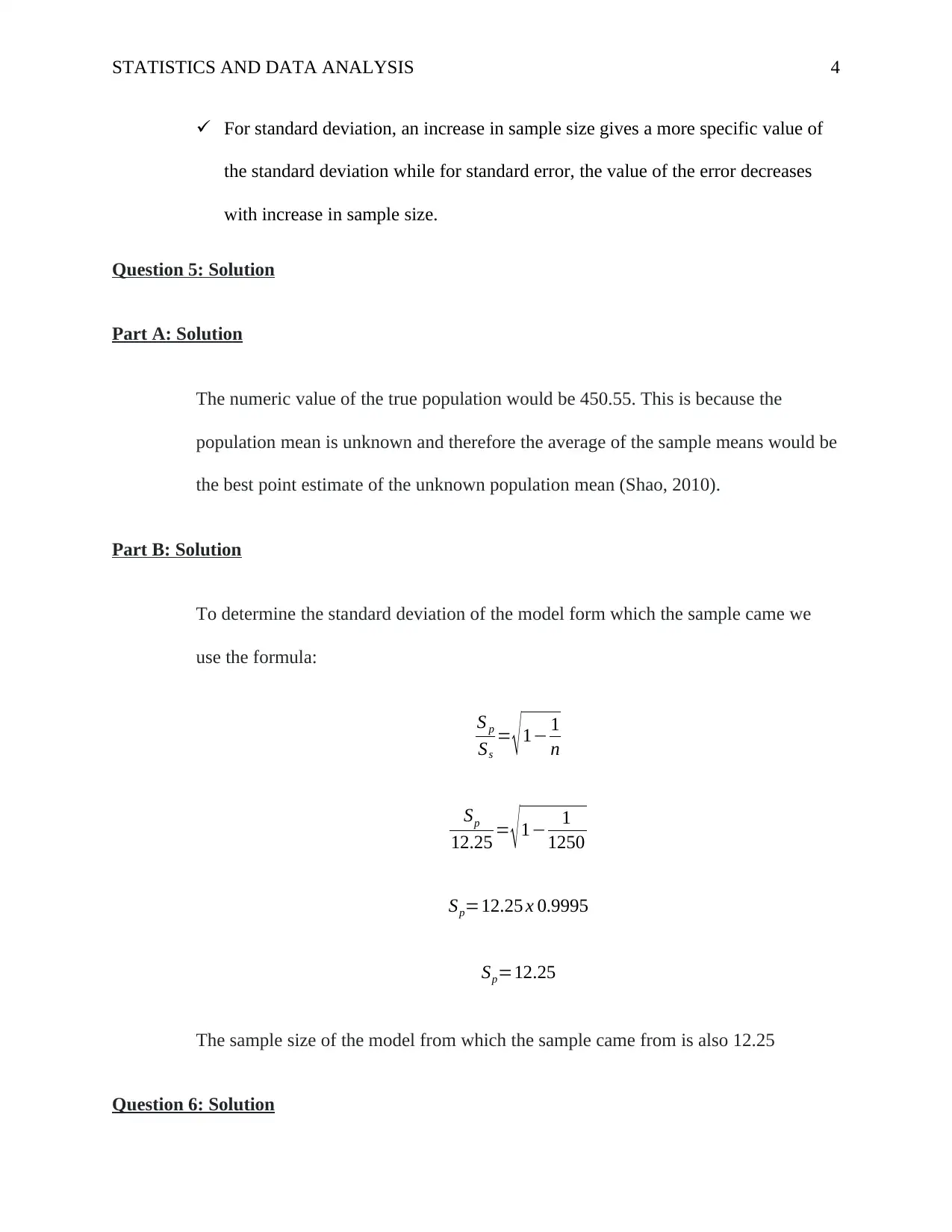
STATISTICS AND DATA ANALYSIS 4
For standard deviation, an increase in sample size gives a more specific value of
the standard deviation while for standard error, the value of the error decreases
with increase in sample size.
Question 5: Solution
Part A: Solution
The numeric value of the true population would be 450.55. This is because the
population mean is unknown and therefore the average of the sample means would be
the best point estimate of the unknown population mean (Shao, 2010).
Part B: Solution
To determine the standard deviation of the model form which the sample came we
use the formula:
S p
Ss
= √ 1− 1
n
Sp
12.25 = √1− 1
1250
Sp=12.25 x 0.9995
Sp=12.25
The sample size of the model from which the sample came from is also 12.25
Question 6: Solution
For standard deviation, an increase in sample size gives a more specific value of
the standard deviation while for standard error, the value of the error decreases
with increase in sample size.
Question 5: Solution
Part A: Solution
The numeric value of the true population would be 450.55. This is because the
population mean is unknown and therefore the average of the sample means would be
the best point estimate of the unknown population mean (Shao, 2010).
Part B: Solution
To determine the standard deviation of the model form which the sample came we
use the formula:
S p
Ss
= √ 1− 1
n
Sp
12.25 = √1− 1
1250
Sp=12.25 x 0.9995
Sp=12.25
The sample size of the model from which the sample came from is also 12.25
Question 6: Solution
Paraphrase This Document
Need a fresh take? Get an instant paraphrase of this document with our AI Paraphraser
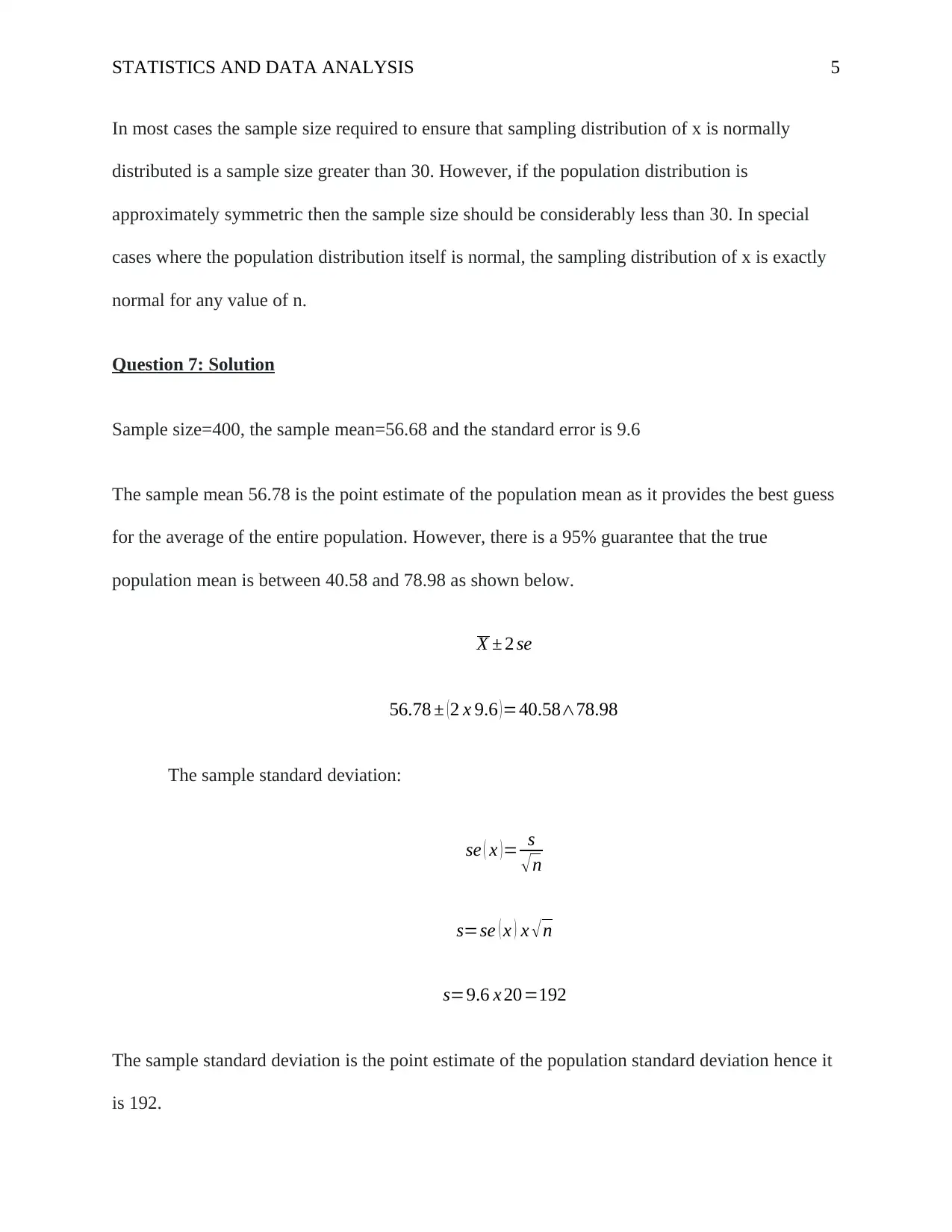
STATISTICS AND DATA ANALYSIS 5
In most cases the sample size required to ensure that sampling distribution of x is normally
distributed is a sample size greater than 30. However, if the population distribution is
approximately symmetric then the sample size should be considerably less than 30. In special
cases where the population distribution itself is normal, the sampling distribution of x is exactly
normal for any value of n.
Question 7: Solution
Sample size=400, the sample mean=56.68 and the standard error is 9.6
The sample mean 56.78 is the point estimate of the population mean as it provides the best guess
for the average of the entire population. However, there is a 95% guarantee that the true
population mean is between 40.58 and 78.98 as shown below.
X ± 2 se
56.78 ± (2 x 9.6 )=40.58∧78.98
The sample standard deviation:
se ( x )= s
√n
s=se ( x ) x √n
s=9.6 x 20=192
The sample standard deviation is the point estimate of the population standard deviation hence it
is 192.
In most cases the sample size required to ensure that sampling distribution of x is normally
distributed is a sample size greater than 30. However, if the population distribution is
approximately symmetric then the sample size should be considerably less than 30. In special
cases where the population distribution itself is normal, the sampling distribution of x is exactly
normal for any value of n.
Question 7: Solution
Sample size=400, the sample mean=56.68 and the standard error is 9.6
The sample mean 56.78 is the point estimate of the population mean as it provides the best guess
for the average of the entire population. However, there is a 95% guarantee that the true
population mean is between 40.58 and 78.98 as shown below.
X ± 2 se
56.78 ± (2 x 9.6 )=40.58∧78.98
The sample standard deviation:
se ( x )= s
√n
s=se ( x ) x √n
s=9.6 x 20=192
The sample standard deviation is the point estimate of the population standard deviation hence it
is 192.
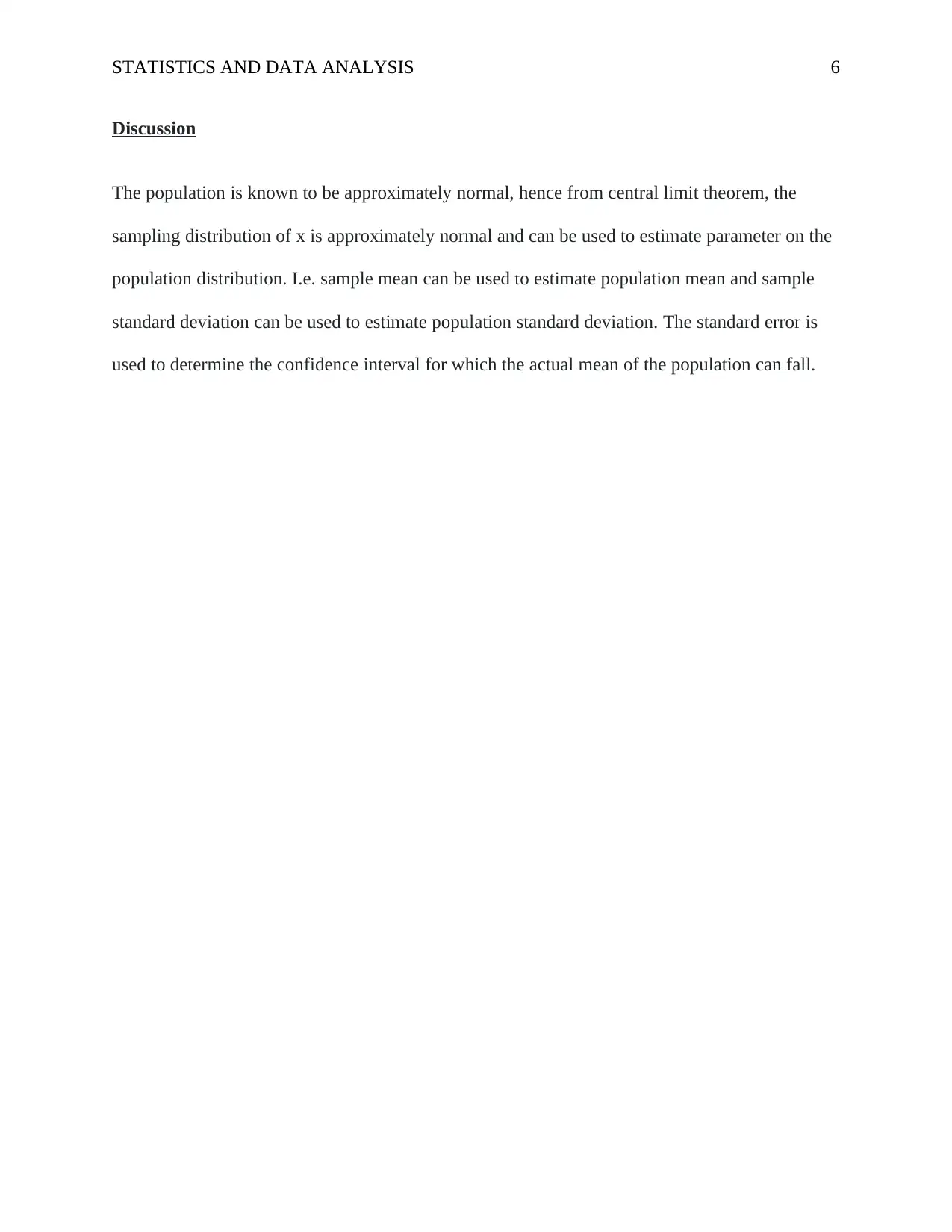
STATISTICS AND DATA ANALYSIS 6
Discussion
The population is known to be approximately normal, hence from central limit theorem, the
sampling distribution of x is approximately normal and can be used to estimate parameter on the
population distribution. I.e. sample mean can be used to estimate population mean and sample
standard deviation can be used to estimate population standard deviation. The standard error is
used to determine the confidence interval for which the actual mean of the population can fall.
Discussion
The population is known to be approximately normal, hence from central limit theorem, the
sampling distribution of x is approximately normal and can be used to estimate parameter on the
population distribution. I.e. sample mean can be used to estimate population mean and sample
standard deviation can be used to estimate population standard deviation. The standard error is
used to determine the confidence interval for which the actual mean of the population can fall.
⊘ This is a preview!⊘
Do you want full access?
Subscribe today to unlock all pages.

Trusted by 1+ million students worldwide
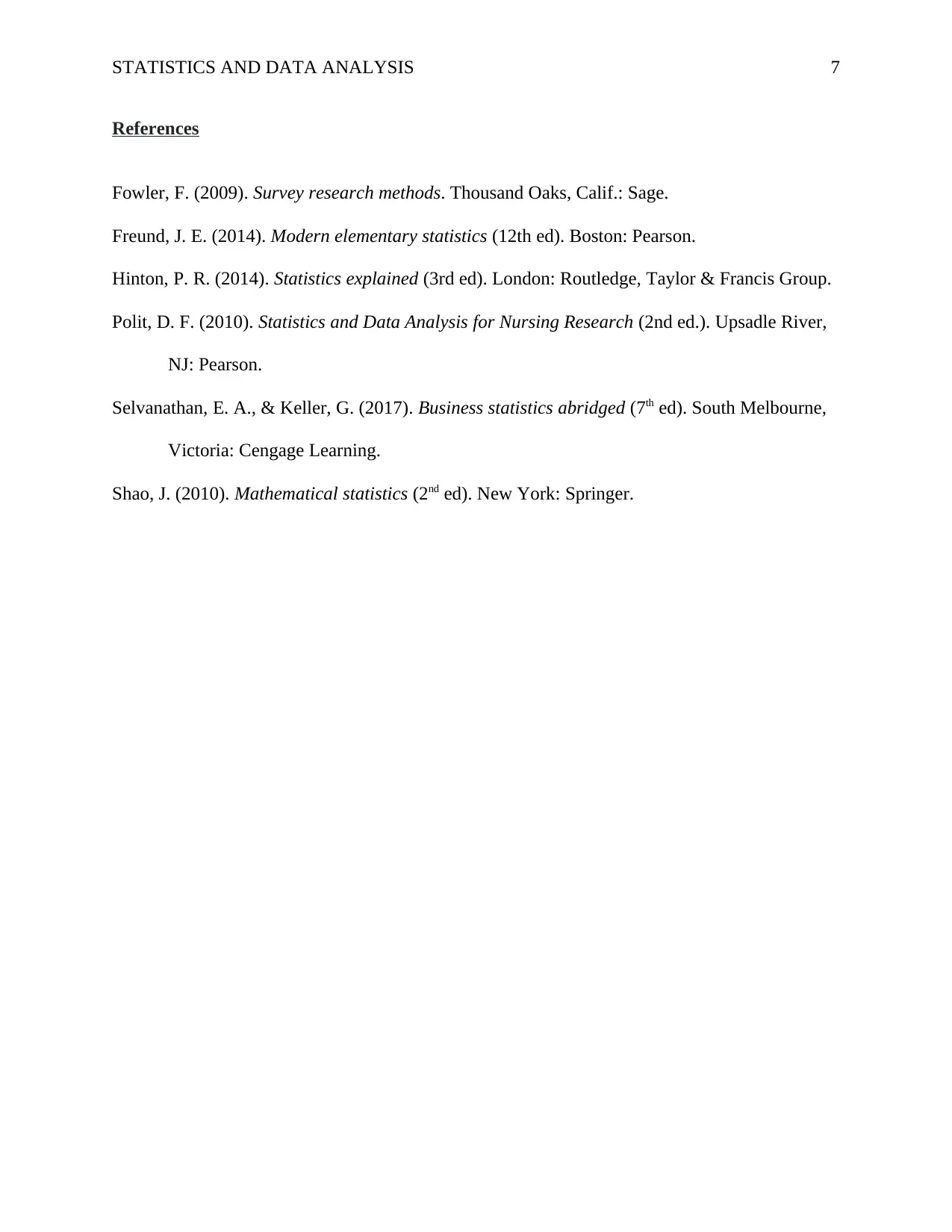
STATISTICS AND DATA ANALYSIS 7
References
Fowler, F. (2009). Survey research methods. Thousand Oaks, Calif.: Sage.
Freund, J. E. (2014). Modern elementary statistics (12th ed). Boston: Pearson.
Hinton, P. R. (2014). Statistics explained (3rd ed). London: Routledge, Taylor & Francis Group.
Polit, D. F. (2010). Statistics and Data Analysis for Nursing Research (2nd ed.). Upsadle River,
NJ: Pearson.
Selvanathan, E. A., & Keller, G. (2017). Business statistics abridged (7th ed). South Melbourne,
Victoria: Cengage Learning.
Shao, J. (2010). Mathematical statistics (2nd ed). New York: Springer.
References
Fowler, F. (2009). Survey research methods. Thousand Oaks, Calif.: Sage.
Freund, J. E. (2014). Modern elementary statistics (12th ed). Boston: Pearson.
Hinton, P. R. (2014). Statistics explained (3rd ed). London: Routledge, Taylor & Francis Group.
Polit, D. F. (2010). Statistics and Data Analysis for Nursing Research (2nd ed.). Upsadle River,
NJ: Pearson.
Selvanathan, E. A., & Keller, G. (2017). Business statistics abridged (7th ed). South Melbourne,
Victoria: Cengage Learning.
Shao, J. (2010). Mathematical statistics (2nd ed). New York: Springer.
1 out of 7
Related Documents
Your All-in-One AI-Powered Toolkit for Academic Success.
+13062052269
info@desklib.com
Available 24*7 on WhatsApp / Email
![[object Object]](/_next/static/media/star-bottom.7253800d.svg)
Unlock your academic potential
Copyright © 2020–2025 A2Z Services. All Rights Reserved. Developed and managed by ZUCOL.





